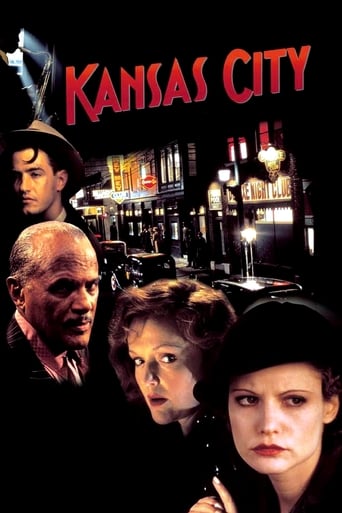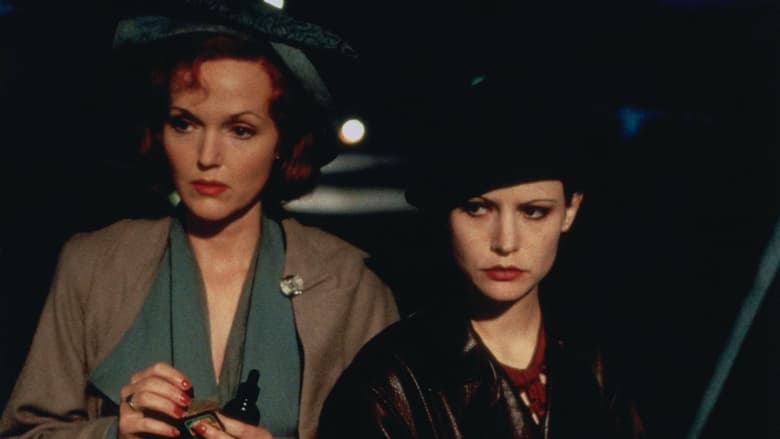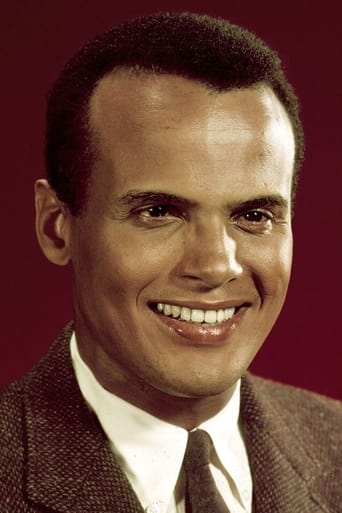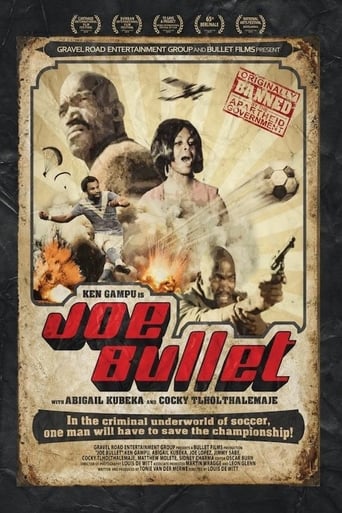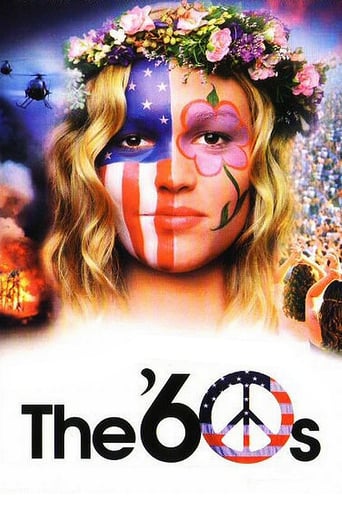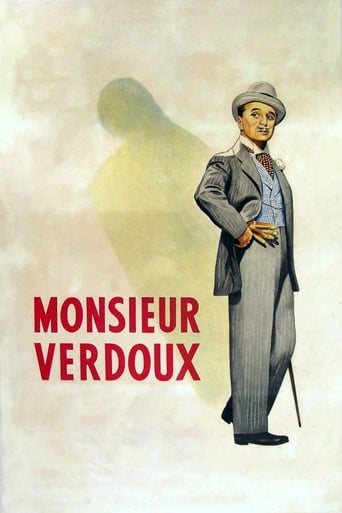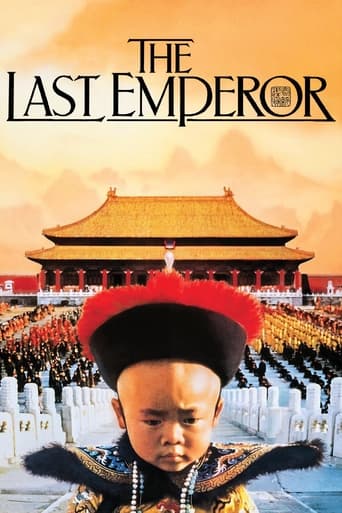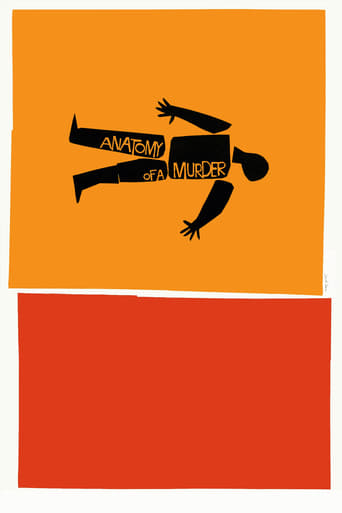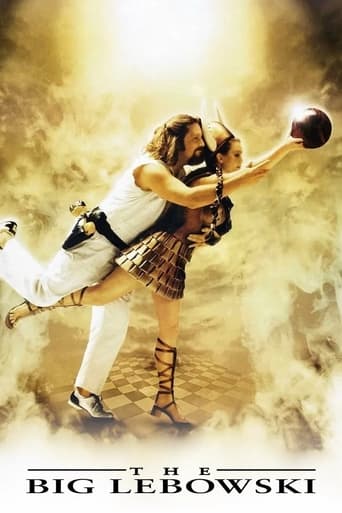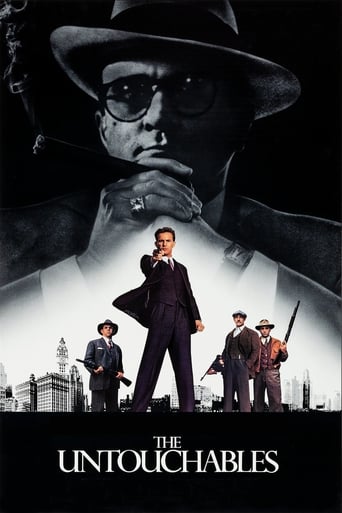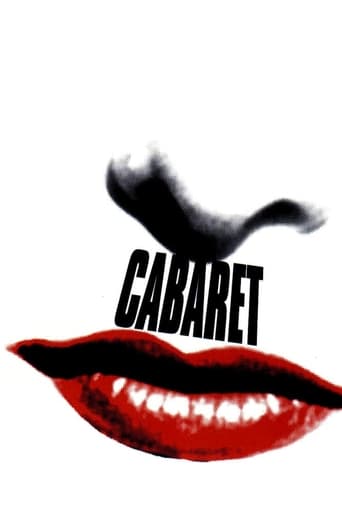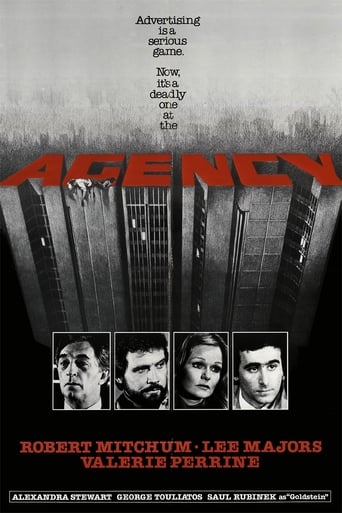Kansas City (1996)
A pair of kidnappings expose the complex power dynamics within the corrupt and unpredictable workings of 1930s Kansas City.
Watch Trailer
Cast


Similar titles
Reviews
How sad is this?
Great Film overall
Good concept, poorly executed.
There is, somehow, an interesting story here, as well as some good acting. There are also some good scenes
A kidnapping and a robbery move the plot forward in a film that's less about plot than about cultural ambiance. "Kansas City" is mostly a cinematic expression of place and time. It's 1934, when gangsters and jazz ruled and Blacks and Whites went their separate ways.Visuals are very dark. And though the film is in color, tints are muted, which conveys a nostalgic, sentimental mood. The thin plot takes place largely at night. And the plot alternates with dark interior scenes at the Hey Hey Club, a risqué, all-Black speakeasy where an all-Black band jives free-form jazz, and where illegal gambling fills the back rooms.None of the characters are sympathetic. But I don't think they're supposed to be. They're archetypes, models of desperate people in desperate times. A gun-wielding gangster's girl named Blondie (Jennifer Jason Leigh) wants to be like Jean Harlow. Mrs. Stilton (Miranda Richardson) is a wealthy, spaced-out politician's wife. Seldom Seen (based on a real-life person and played by Harry Belafonte) is the cigar smoking godfather who rules the dark, smoky Hey Hey Club with an iron fist and who likes to stand around giving lectures to people.The script's dialogue is mostly subtext, with message directed less at other characters than at viewers. And, as in other Altman films, then-current politics dance around the edges of the seedy story. The overall tone mixes depression with desperation.For me this is an easy film to judge. The characters and plot I cared for not at all. Jennifer Jason Leigh was painful to watch. And though the jazz is performed with great competence, its free-form, improvisational style is too contemporary to reflect the 1930s. On the other hand, Miranda Richardson gives a fine performance. Attention to detail in costumes, sets, props, and storefront exteriors make the film come alive with era realism. And lighting is absolutely terrific.If you go into this movie expecting a deep story and well-constructed plot, you'll be disappointed. Absorb the overall texture of the film's visuals. "Kansas City" is a terrific visual portrait of a specific place at a specific time.
After a new born to a new audience with excellent "The Player" and "Short Cuts" and slip down with the weird and unfunny "Prét-à-Porter", the master of the independent cinema Robert Altman gets back with a minor but interesting work in "Kansas City". Here, he reveals the dangerous Kansas City of the 1930's with their corrupt politicians, scary mobsters and people involved with all this world without noticing the danger right ahead.In the 1930's the young and beautiful Blondie (Jennifer Jason Leigh) kidnaps Carolyn (Miranda Richardson) the wife of a powerful politician (Michael Murphy) who can help her to save her boyfriend Johnny (Dermot Mulroney), a little burglar who stole an important big shot in the crime world, and now he's going to be killed by another powerful mob figure, the gangster Seldom Seen (Harry Belafonte). The frightened Carolyn is dragged away along with Blondie to several places in town, trying to get along with each other, which doesn't work quite well because of their different backgrounds. Blondie is addicted to the films of Jean Harlow and she keeps annoying her hostage all the way; while Carolyn is an addicted to opium that barely gets out of the house, suffering with her addiction. In the meantime the politician keeps dealing with the case, in a very discreet way to not ruin his future election that its getting ahead and because of his proximity with President Roosevelt. On the other part of town, Johnny has the chance to know more about what the real world of crime really is, listening to Seldom's menacing stories and to lots of jazz that is played in his captivity. Besides these two kidnaps there's a subplot concerning a girl who came to town to get an abortion and a political scandal involving a party which is buying votes to win the election using of deadly tactics. The same team of writers who signed "Short Cuts" tries to unite several characters that follow the same path in several situations having as link the jazz as musical background played in almost every scene. As I said, they tried to unite them but they end up confusing the public by dividing two situations, apparently disconnected, that will meet in the end, and until it get to the final result you keep wondering what's the reason for both kidnaps. When the two parts get together it all makes sense but before some answers appear many will have walked away of the movie because everything is slow, almost tedious. The perfect "Short Cuts" which tells the story of 23 characters crossing the way of each other in a chaotic Los Angeles, in a excellent tragicomedy of the real life, gets way better than "Kansas City" with their 6 main characters. On the other hand this confusion in dividing the film in two situations makes a intriguing film that makes the audience wants to know of what happens next.As favorable points, "Kansas City" has a great period reconstitution, the costumes of the 1930's, the old cars; the music (Altman worked the same musicians who appeared in his documentary "Jazz 34"); and a great performance by Harry Belafonte as the talking gangster who has an answer to everything. Michael Murphy surprises a lot in his short moments in which he appears; the other performances are not so interesting, sometimes they are very annoying, and that is the case of the main pair. Jennifer Jason Leigh's voice is tiring and very debauched for a dramatic film; Miranda Richardson has a very aloof character, a role that she would dominate better in the great "Falling Angels".Robert Altman made a good job despite not being too much impressive as his previous works. 8/10
I am an unabashed admirer of the personal in film. I suppose cinematic personality can be expressed in a variety of ways, but I value it most when its from a filmmaker, and it affects the cinematic vocabulary. I like Altman. Yes, I like certain films of his: these stand on their own outside of the long term dialog I've had with him.But I like the dialog as well, that long languid experience of punctuated experiments in his worlds and then mine.What he does, where his core experiments are rooted is in the rhythm of how he puts his films together. Its unlike anything else that could be considered competently relevant in film. His interest is in the notion of discovered pace.To understand why this is so weird, and sometimes so unsettling, you have to understand that there are very strict conventions in the business about what viewers will accept in terms of the pace, arc and rhythm of a film. Editors and filmmakers learn these conventions either through understanding the theory, through intuition or experience, depending on their approach. Its very, very narrow, what these allow.Regular readers of my comment know I believe that TeeVee is one of the worst evils we face. It is because it forces this vocabulary to be ever more narrow, constriction the visual imagination of a whole planet.Altman is a sort of Moses in this environment, trying every escape he can imagine. He tries to let actors surprise the camaraman and editor. He tries strange overlaps in scenes. He tries all sorts of parallel narratives. He particularly likes to juggle several layers of the narrative at once with contradictory, even warring cadences.Here what he does is work with three rhythms. The first is the obvious one, jazz, and particularly the style originating in Kansas City.The style can be directly attributable to the type of political corruption that dominated the town, extreme even when compared to Chicago and St Louis. The corruption is based on a sort of lie that pretends to be the truth but is bent. You can see it here in the voting. In Chicago at this time there would be no pretense: dead people's ballots would simply appear in the ballot box without the show of hiring bodies to cast them. Blacks would simply be ignored at best without the church performing nominal help (and then lynching). (This church-influenced near-truth politics still dominates the town, even famously to the court system. You do not want a trial in Kansas City.)So we have the jazz playing, and influencing the action while political power and "helping" a 14 year old pregnant black girl are suspended. Its a particular trading of phrases that if you listen you can see reflected in the structure: particularly the twisted flash-forwards of the narrative arrangement.Then you have the characters of the two women, each with their own world-rhythms. The character played by Jason Leigh is typical of what she can do personality-wise. Here it actually matters because of the way she pushes the future with the way she shapes words with an aggressive mouth. There's much to say here in the story about how this is folded into a similar character-induced pacing devised by Jean Harlow, who Leigh's character emulates. Harlow was in fact from Kansas City and her style was self-consciously KC jazz- influenced.The other character is played by Miranda Richardson, who (unlike her sister) had at the time a reputation for stiff English types. Here she plays something like that, one of those third generation frontier types with corn aristocracy, now turned vapid from drugs. Its a pretty layered performance, every big as complex as Leigh's. She also has a sort of nonlinear time based on rewriting and scrambling.Its an amazing construction, a thrilling experiment. By design, it lacks the sort of pace you come to expect. That's the point. Anyone who complains that it doesn't do well pacewise, just doesn't get it and if they were in the movie, would be disemboweled and then shot by a bullet through your girlfriend.Ted's Evaluation -- 3 of 3: Worth watching.
This movie does a good job of portraying a 1930s Kansas City of mobsters, racial unrest, petty criminals and jazz, and if all it took to make a good movie was atmosphere then this would be a great film. But all this movie has is atmosphere, and it's not enough. I'm not a big fan of Altman (I like about 1 out of every 15 of his movies) but I watch anything Jennifer Jason Leigh is in, so I had to watch it. Leigh is fine but this is not one of those electric performances that has made me such a fan. I don't think it's possible to bring any electricity to this lumbering creature. I was incredibly bored throughout and only kept watching out of a vague curiosity as to how it would all turn out, but at the final I felt heavy and almost paralyzed with boredom and disinterest. I'd say this is for Altman fans only.

